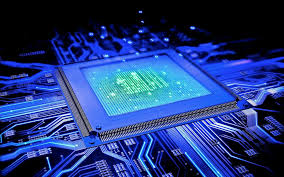The Intrinsic semiconductors are extremely pure semiconductor. A good example of such elements includes silicon(Si), germanium(Ge),Selenium(Se) and Tellurium (𝑇𝑒). These semiconductors have their outmost shell occupied by 4 electrons .
Their outer most electrons combines covalently with electrons from their neighboring atoms to form a crystal. each atom is hence surrounded by 4 other atoms.
Silicon atoms bond covalently by sharing their four valence electrons with four other silicon atoms, forming a stable, three-dimensional tetrahedral network. Each silicon atom is bonded to four neighbors, and each bond consists of a shared pair of electrons, which helps the silicon atoms achieve a stable outer shell configuration. The figure below illustrates formation of silicon structure.

At absolute zero temperature(-273.16K), the semiconductor crystal is an insulator. At room temperature, some electrons in the valence band gains enough energy to move to the conduction band leaving behind holes in the valence band. This movement makes the element a conductor. At higher temperatures, more electron are moved to the conduction bands and more holes are created. This increases the conductivity of the semiconductor material.
In an intrinsic semiconductor, the number of electrons equals the number of holes.
charge carriers
The electrons and the holes are referred to as the charge carriers. Small quantities of impurities may be added to an intrinsic semiconductors to enhance it’s conductivity on a process known as doping. An intrinsic semiconductor to which impurities have been added to enhance conductivity is referred to as an extrinsic semiconductor. Extrinsic semiconductors can be classified as either n-type or p-type semi-conductor. Depending on the type of semi-conductor created from doping, we develops majority and minority charge carriers.
Majority and minority charge carriers are electrons and holes that carry electric current in a semiconductor. Majority charge carriers are the most abundant type while minority charge carriers are the lesser in number.
The n-type semiconductors
This is formed by doping an intrinsic semiconductor with a pentavalent atoms. A pentavalent atom is an atom that has five valence electrons in its outermost shell. These elements belong to Group 15 of the periodic table, also known as the pnictogens. Pentavalent atoms are primarily found in the nitrogen group (Group 15) of the periodic table and include: Bismuth (Bi),Nitrogen (N),Phosphorus (P),Arsenic (As)and Antimony (Sb).
When a pentavalent atoms is introduced into the impure semiconductor,4 of it’s 5 electrons forms a covalent bond with 4 neighboring atoms of the intrinsic semiconductor.
This causes to be a free electron that is not bound to an atom. This free electron can thus be used for electrical conductivity.


Electrons becomes majority charge carriers while holes becomes minority charge carriers.
Note: n-type semiconductor is electrically neutral since the total number of electrons is equal to the total number of protons in the material.
The atom added to the intrinsic semiconductor is referred to as the donor atom. For pentavalent atoms, they can also be referred to as the n-type impurity.
The P-type semiconductor
This is a type of semiconductor obtained by doping an intrinsic semiconductors with trivalent atoms.
Trivalent atoms are atoms that have a valence of three, meaning they have three electrons in their outermost shell or can form three covalent bonds. Examples include boron (B), aluminum (Al), and nitrogen (N) and Indium.
As an example, consider a boron atom being injected into silicon atom. Because boron has three electrons in it’s outer shell, it will have one electron less to complete the bonding when fitting into the silicon lattice. There will thus be a vacant place due to the missing electron which is a hole. The silicon crystal thus becomes an extrinsic semiconductor with holes as the majority charge carriers. The resulting semiconductor is referred to as the P-type semiconductor because the majority charge carriers are holes with an effective positive charge.


A trivalent atom that completes bonding in an intrinsic semiconductor with one atom less to create a hole is known as an acceptor atom.
Electrons are minority charge carriers while holes are the majority charge carriers in a p-type extrinsic semiconductor.
The p-type semiconductor however, is not positively charged but electrically neutral. This is because the impurity introduces equal number of electrons and protons found in the nucleus.
Fixed ions
In P-type semiconductor holes are the majority charge carriers. As holes moves away from the parent atom, they make the atom to be a negative ion which is fixed in the crystal. This ion does not take part in conduction. electrons which are thermally generated exists as the minority charge carriers. See the illustration below.

In the n-type semiconductor, an electron moving away from a parent atom generates a fixed positive ion. The holes are thermally generated while electrons are as a result of doping. The figure below shows the fixed ion from the n-type semiconductor.

Related topics
- Getting started With Python
- Python Key Words
- AI Vocabulary

